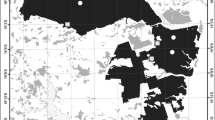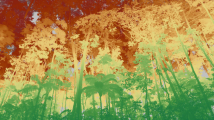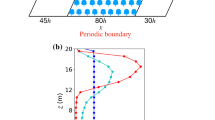Abstract
This work explores the dry season micrometeorology of fragmented forests in Amazonia. Numerical simulations with a coupled atmosphere-vegetation model show that mesoscale moisture transport leads to a significant drying and vegetation stress at the forest edges. Increased evaporation cannot fully compensate for the drying. Typical convective precipitation events that occur in the dry season have a localized impact and do not affect the drying trend in the long term. Availability of soil moisture can partially mitigate the drying effect and consequent vegetation stress. Edge effects can dominate the vegetation dynamics and fire susceptibility of forest fragments as a whole. Hence, understanding the dynamics and drivers of edge effects is crucial for understanding the ecology and future of tropical forests in a changing climate.




Similar content being viewed by others
References
Baidya Roy S (2009) Mesoscale vegetation atmosphere feedbacks in Amazonia. J Geophy Res 114. doi:10.1029/2009JD012001
Baidya Roy S, Avissar R (2002) Impact of land use/land cover change on regional hydrometeorology in Amazonia. J Geophys Res 107. doi:10.1029/2000JD000266
Bogaert J, et al. (2008) Fragmentation of Forest Landscapes in Central Africa: Causes, Consequences and Management. Agriculture 1–67.
Briant G, Gond V, Laurance SG (2010) Habitat fragmentation and the desiccation of forest canopies: a case study from eastern Amazonia. Biol Conserv 143:2763–2769
Broadbent E et al (2008) Forest fragmentation and edge effects from deforestation and selective logging in the Brazilian Amazon. Biol Conserv 140:142–155
Calvet JC et al (1997) Mapping surface parameters for mesoscale modeling in forested and deforested south-western Amazonia. Bull Amer Meteorol Soc 78:413–423
Chagnon FJF, Bras RL (2005) Contemporary climate change in the Amazon. Geophys Res Lett. doi:10.1029/2005GL022722
Cotton WR et al (2003) RAMS 2001: Current status and future direction. Meteorol Atmos Phys 82:5–29
Curran LM et al (2004) Lowland Forest Loss in Protected Areas of Indonesian Borneo. Science 2004:1000–1003
de Filho FJBO, Metzger JP (2006) Thresholds in landscape structure for three common deforestation patterns in the Brazilian Amazon. Landscape Ecol 21:1061–1073
Gascon C, Williamson GB, da Fonseca GAB (2000) Receding Forest Edges and Vanishing Reserves. Science 288:1356–1358
Giambelluca TW et al (2003) Transpiration in a small tropical forest patch. Agric Forest Metorol 117:1–22
Grace J et al (1995) Fluxes of carbon dioxide and water vapor over an undisturbed tropical forest in southwest Amazonia. Global Change Biol 1:1–12
IPCC (2008) Climate change and water. Bates, BC et al. Eds. IPCC Secretariat, Geneva, 210 pp.
Koster RD, Suarez MJ (1992) Modeling the Land Surface Boundary in Climate Models as a Composite of Independent Vegetation Stands. J Geophys Res 97:2697–2715
Laurance WF et al (2010) The fate of Amazonian forest fragments: A 32-year investigation. Biol Conserv 144:56–67
Messina JP, Cochrane MA (2007) The Forests are Bleeding: How land use change is creating a new fire regime in the Ecuadorian Amazon. J Latin American Geog 6:85–100
Salmun H, Molod A, Ira A (2007) Observational validation of an extended mosaic technique for capturing subgrid scale heterogeneity in a GCM. Tellus 59:625–632
Skole D, Tucker C (1993) Tropical deforestation and habitat fragmentation in the Amazon: Satellite data from 1978 to 1988. Science 260:1905–1910
Uriarte M et al (2010) Effects of forest fragmentation on the seedling recruitment of a tropical herb: assessing seed vs. safe-site limitation. Ecology 91:1317–1328
Wang J et al (2009) Impact of deforestation in the Amazon basin on cloud climatology. Proc Natl Acad Sci 106:3670–3674
Author information
Authors and Affiliations
Corresponding author
Electronic supplementary materials
Below is the link to the electronic supplementary material.
ESM 1
(DOC 527 kb)
Rights and permissions
About this article
Cite this article
Baidya Roy, S. Mesoscale moisture transport effects on forest edges in a fragmented landscape in Amazonia. Climatic Change 108, 609–617 (2011). https://doi.org/10.1007/s10584-011-0218-2
Received:
Accepted:
Published:
Issue Date:
DOI: https://doi.org/10.1007/s10584-011-0218-2




